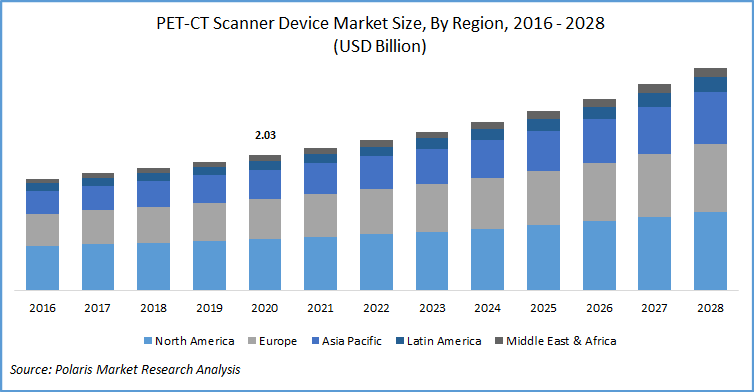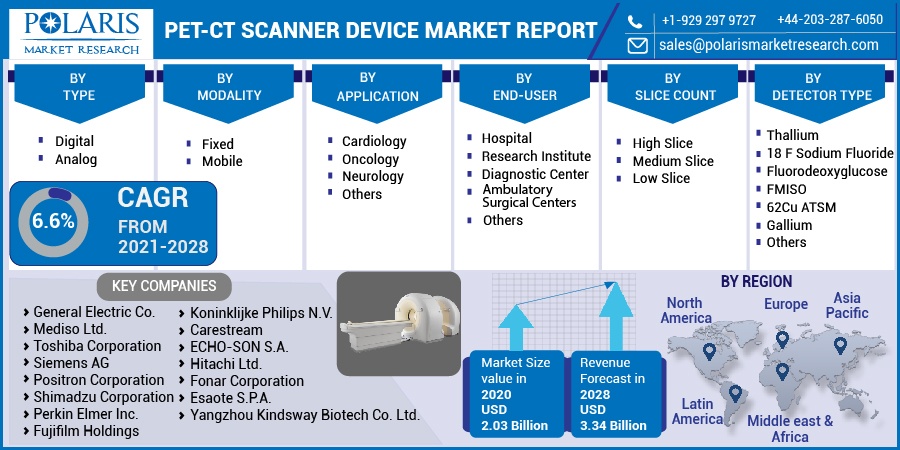
PET-CT Scanner Device Market Share, Size, Trends, Industry Analysis Report, By Application (Cardiology, Oncology, Neurology); By End-Use (Hospital, Research Institute, Diagnostic Center, Ambulatory Surgical Centers); By Type; By Modality; By Slice Count; By Detector Type; By Region; Segment Forecast, 2021 - 2028
- Published Date:Apr-2021
- Pages: 112
- Format: PDF
- Report ID: PM1838
- Base Year: 2020
- Historical Data: 2016-2019
Report Outlook
The global PET-CT scanner device market size was valued at USD 2.03 billion in 2020 and is anticipated to grow at a CAGR of 6.6% during the forecast period. The product provides imaging of anatomy and metabolic function within the body in a single scan. It is non-invasive, requires no downtime afterward, and enables differentiation between a cancerous and noncancerous mass.
 Know more about this report: Request for sample pages
Know more about this report: Request for sample pages
The product is increasingly being used for the detection of cancer, assessment of the effectiveness of treatment, evaluation of prognosis, identification of weak heart muscles, analysis of brain abnormalities, and assessment of tissue metabolism and viability. The increasing occurrence of chronic diseases, inclusion of scanning under Medicare, and growing investments in the development of advanced healthcare equipment by governments and private organizations are some factors expected to fuel the demand for the product during the forecast period.
PET-CT device is a combination of positron emission tomography (PET) detectors and computed tomography (CT). The PET-CT scanner devices combine the metabolic data from the scan with the detailed anatomic data from the CT scan device to deliver highly detailed images. The scanners use radioactive glucose, which is injected into a vein to detect tumor cells, which consume more glucose than normal cells.
Industry Dynamics
Growth Drivers
The product offers improved patient outcomes offering high accuracy in diagnoses. These products also assist in developing improved targeted treatment plans, and less-invasive treatment monitoring. PET-CT scanner devices offer enhanced patient comfort by reducing scan time and the number of scanning sessions.
Technological advancements and significant investments in research and development support market growth. New product launches and acquisitions by leading players in the market have increased the demand for the product across the globe. In August 2019, United Imaging announced the first installation of its uExplorer total-body PET-CT system.
uExplorer is a result of collaboration between United Imaging and the Explorer Consortium. uExplorer requires 20 to 30 seconds for total-body imaging in a single bed position. uExplorer enables continuous tracking of tracer distribution in blood, organs, and tissues at high speed and efficiency. It also assists and supports pharmacokinetic studies and radiation dose evaluation.
In October 2019, GE Healthcare collaborated with Theragnostics for the development of a prostate-specific membrane antigen (PSMA) imaging agent. GalliProst, which is a tracer for the detection of prostate cancer is being developed by Theranostics. GE Healthcare is responsible for pre-approval commercial preparations, and commercial and distribution activities.
The new tracer enables the generation of a heatmap-style image presenting the precise location and intensity of prostate cancer cells. The global market is also fueled by increasing demand from countries such as China, Japan, and India, growing geriatric population, and rising healthcare expenditure. Global players are expanding into developing countries to tap market potential, further boosting the market growth.

Know more about this report: Request for sample pages
PET-CT Scanner Device Market Report Scope
The market is primarily segmented on the basis of type, modality, application, end-use, slice count, detector type, and region.
|
By Type |
By Modality |
By Application |
By End-User |
By Slice Count |
By Detector Type |
By Region |
|
|
|
|
|
|
|
Know more about this report: request for sample pages
Type Outlook
On the basis of type, the market is segmented into digital and analog. The demand for digital segment is expected to increase during the forecast period. Digital scanners are equipped with solid-state sensors, which enable the counting of individual scintillation photons during a scan. These scanners enhance the quality of images thereby improving chances of detection of lesions while reducing the scan time.
Modality Outlook
The market is segmented into fixed and mobile based on modality. The fixed PET-CT scanner device segment dominated the global market for PET-CT scanner device in 2020 owing to greater reliability, and improved efficiency. Fixed PET-CT scanner devices enhance the patient experience. The increasing geriatric population, changing lifestyles, and growing occurrence of oncology and cardiological disorders have increased the demand for fixed PET-CT scanner devices in hospitals.
Application Outlook
The oncology segment dominated the global market for PET-CT scanner device in 2020. A PET-CT scan combines a CT scan and a PET scan to provide more accurate results. The PET scan uses a mildly radioactive drug to highlight body areas with higher cell activity. PET-CT scanner devices are used to detect and diagnose cancer, the size of the tumor, and the treatment required.
PET scan provides an image reflecting the body’s metabolic and biochemical activity using a low level of radiation, whereas CT scans from devices are responsible for proving detailed information about the location, size, and shape of various lesions and create a 3D picture.
End-Use Outlook
On the basis of end-use, the market is segmented into hospitals, research institutes, diagnostic centers, ambulatory surgical centers, and others. The hospital segment dominated the global market for PET-CT scanner device in 2020. The high traffic environment, advanced healthcare infrastructure, availability of advanced medical devices, and increasing need for diagnostic imaging procedures drives the growth of this segment. Increasing investments in the development of technologically advanced healthcare equipment, greater need to provide improved patient care, and growing adoption of minimally invasive procedures further fuel the growth of this segment.
Slice Count Outlook
The market is segmented into high slice scanners, medium slice scanners, low slice scanners based on slice count. The medium slice scanner segment dominated the global PET-CT scanner device market in 2020. The medium slice scanner is widely used owing to its ability to provide an enhanced view of the size, shape, and position of soft tissue structures. These scanners are also used for the identification of tumors and cysts, and detection of diseases of the liver, lungs, and coronary arteries among others.
Regional Outlook
North America dominated the global market for PET-CT scanner device in 2020. The increasing geriatric population, growing research and development activities, and technological advancements are some factors attributed to the growth of this regional segment. There have been increasing incidences of chronic diseases registered in the region, driving the growth of this region. Rising health concerns established healthcare infrastructure, and growing awareness regarding preventive healthcare and early diagnosis of diseases has increased the demand for PET-CT scanner devices in the region.
Competitive Landscape
The leading players in the PET-CT scanner device market include General Electric Co., Mediso Ltd., Toshiba Corporation, Siemens AG, Positron Corporation, Shimadzu Corporation, Perkin Elmer Inc., Fujifilm Holdings, Koninklijke Philips N.V., Carestream, ECHO-SON S.A., Hitachi Ltd., Fonar Corporation, Esaote S.P.A., and Yangzhou Kindsway Biotech Co. Ltd.
